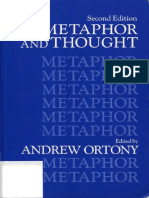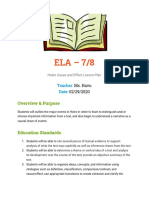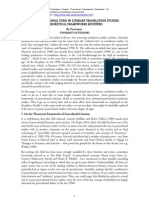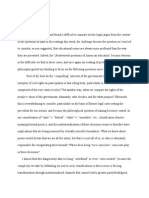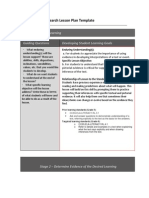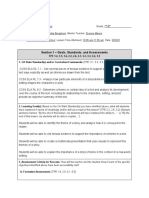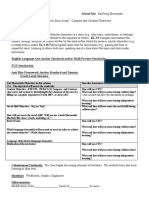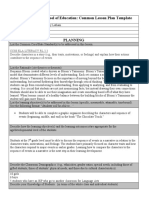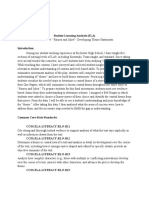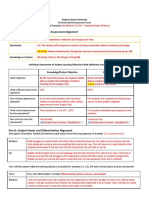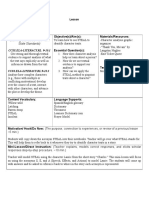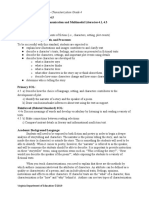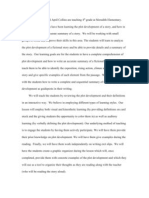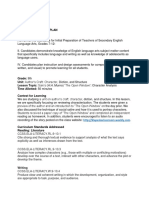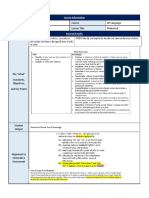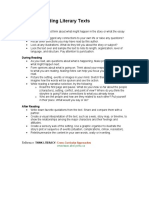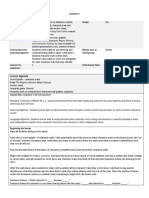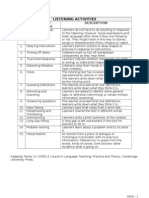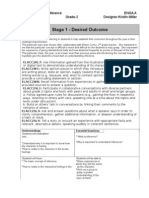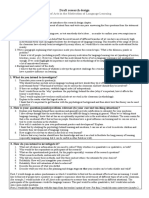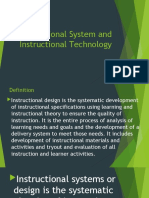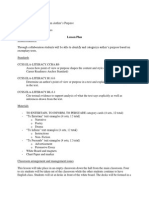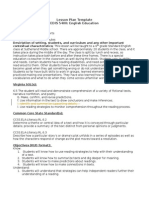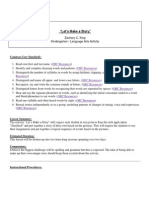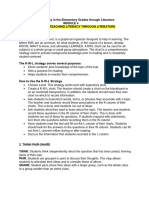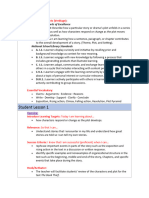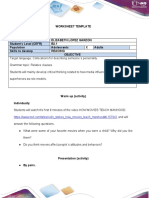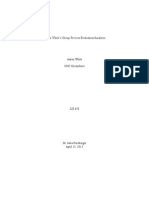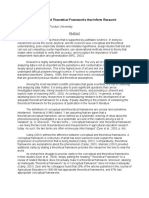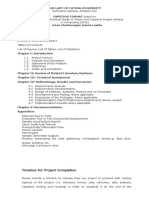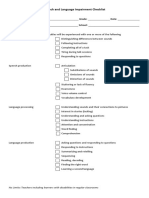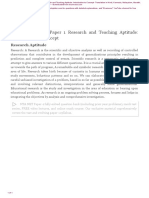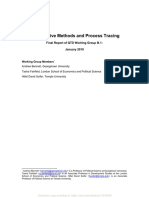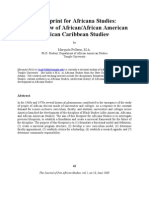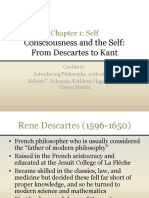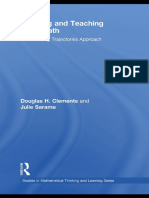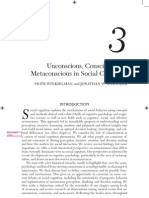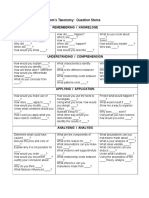Professional Documents
Culture Documents
Aaron White's Assignment 1 University of North Carolina at Greensboro
Aaron White's Assignment 1 University of North Carolina at Greensboro
Uploaded by
api-280698285Original Description:
Original Title
Copyright
Available Formats
Share this document
Did you find this document useful?
Is this content inappropriate?
Report this DocumentCopyright:
Available Formats
Aaron White's Assignment 1 University of North Carolina at Greensboro
Aaron White's Assignment 1 University of North Carolina at Greensboro
Uploaded by
api-280698285Copyright:
Available Formats
Aaron Whites Assignment 1
University of North Carolina at Greensboro
Excerpts from: Assignment 1-Principles of Learning and Learning Theory
Department of Library and Information Science
By
Aaron White
Kannapolis, NC
February, 2013
Aaron Whites Assignment 1
IV. Instructional and Learning Environments
As an aspiring academic librarian, I dont expect to be an instructor in the same
manner as a professor or classroom teacher, but I will need to help people navigate
information repositories and make use of complex user interfaces that cant be engaged
effectively with mere Google-style intuition. Creating Libguides and other learning
resources may be part of my daily work. Face-to-face consultation with puzzled patrons
may also be part of my daily routine.
Moreover, I aspire to act as a formal or informal liaison librarian to the theatre
departments, given my undergraduate instruction in theatre. As an undergraduate I
participated in a play (Our Countrys Good by Timberlake Wertenbaker) that incorporated
historical persons and events. The library supplied an array of books on those historical
subjects to the theatre building for our research purposes. This has remained with me as
an icon of librarianship; not merely warehousing information, but carrying it to where the
need existed, as Ranganathan would wish. I hope to extend beyond providing
information resources; I want to provide help in accessing these texts (not all theatre
students are comfortable dipping into scholarly historical texts) to find useful
information.
Aaron Whites Assignment 1
V. Develop Instruction using ADDIE Model
As a theatre undergraduate, one of my favorite skills was role-specific script
analysis, in which we analyzed a character we intended to play within the text of the
script. The process was as follows:
Read the script
highlight your role, and highlight your cues (the lines of dialogue and
actions that precede, and thus signal, your lines or actions) in a separate
color
Determine your characters objectives, problems, and tactics for each line
or set of lines
o Objective: what does the character want? (Generally to gain,
achieve, prove, or preserve something)
o Problem: What either stands between the character and objective,
or threatens the objective?
o Tactics: What is the character doing to overcome the problem and
achieve the objective?
o As if: think of a situation in your own life in which the emotional
stakes are similar to those of the character in this scene. EX: The
To Be or Not To Be soliloquy Its as if Im considering dropping
out of college, and staying up late thinking through the pluses and
minuses of this decision.
Draw a dividing line (Beat break) between lines of dialog everywhere you
believe there is a change of tactic or objective, and make a marginal note
(in pencil so it can be erased and replaced upon further
reflection/refinement) on the objectives, problems and tactics involved.
Aaron Whites Assignment 1
Ultimately decide what the characters Superobjective, the objective that
underlies all other objectives and never changes, is. This usually takes
time, sometimes weeks, to become clear, as the performer continues to
work with the analysis.
Performing the tasks results in an artifact: a marked-up script. The desired endproduct for an actor is a performance that is shaped and articulated by the analysis and
which articulates the analysis in turn. Declarative and procedural memory work together
in a reinforcing loop. For a scholar the fruits may be entirely declarative rather than
procedural/performative. Since students studying script interpretation may have either a
performative or scholarly interest in the practice, I would allow students to either do a
performative reading of a scene with a partner, or do an oral presentation walking the
class through their analysis.
I would select two scenes from contemporary theatrical scripts and prepare
handouts of the script pages for the class, perhaps including a scene from a play the
campus theatre department would be producing soon. Gaining attention: Id play
recordings of several performances of the famous To be or not to be speech, and ask
students to compare and contrast the different interpretations.
1. Informing learners of the objective: The objective of the class is to
teach students to use a common and systematic process for analyzing a
role and thinking through the characters choices, allowing performers
to create coherent performances.
2. Stimulating recall of prior learning: assuming the students had no prior
grounding in the related concepts, Id ask them to remember times
Aaron Whites Assignment 1
theyd really tried to achieve something that was important to them.
Since plays are about people who really want something and for whom
the stakes are high, part of acting is figuring out the stakes of the
situation, and what people do in response to those stakes.
3. Presenting the stimulus: Introduce the key words and phrases:
Objective, Problem, Tactic, As If, Superobjective.
4. Providing learning guidance. Walk the students through a printed
scene (with handout copies; assigning roles to volunteers and having
them read it aloud) then have the class work through the scene,
deciding what the objectives, problems and tactics are. Ask questions
such as Whats (character name)s objective at the start of the scene?
Where might the first beat change be? Whats the cause of that
change? Is it a tactic change, or an objective change?
5. Eliciting performance: Break the class into small groups to read
through another scene, then analyze it, figuring out the objectives,
problems, tactics, and beats. Then have each group explain their
analysis.
6. Providing feedback. Script analysis is not an exact science, and
allowing students to come to their own conclusions is part of the job,
but Id help the students keep the procedural steps in mind and prod
their memory in case they skipped or misunderstood a step as we
worked through their analyses. Id also answer questions about the
process of analysis.
7. Assessing performance. The students will demonstrate the extent to
which they initially grasp the procedure and purpose of this analytic
process through doing such analysis. If it seems some of them are
Aaron Whites Assignment 1
struggling with the process or purpose of any or all steps, Id work
with them to ensure they understood how the process works and how it
helps give performers a basis for coherent, assured performances.
8. Enhancing retention and transfer. Homework would be to do a solo
analysis of another scene. Before breaking, wed quickly run down
the stages of the process once again.
Assessing the richness and insight of a students scene interpretation has a strong
subjective element that Id wish to minimize in favor of assessing the extent to
which the students documentation of beat breaks and objectives/problems/tactics
demonstrated an understanding of the process. Along with marking the beat
breaks and O/P/T changes in the assigned scene, Id ask the students to write brief
(500 words or so) explanations of their thought processes in their analysis. If this
were a recurring class, the next class could include the students sharing their
interpretations.
You might also like
- The Bet Lesson PlanDocument10 pagesThe Bet Lesson Planapi-265180782No ratings yet
- A.ortony - Metaphor and ThoughtDocument350 pagesA.ortony - Metaphor and ThoughtAnonymous uD8YEGV100% (2)
- Contemporary Philosophy: The Promise of Philosophy and The Landmark ForumDocument9 pagesContemporary Philosophy: The Promise of Philosophy and The Landmark ForumTim20C100% (2)
- Antonia LoLordo Pierre Gassendi and The Birth of Early Modern PhilosophyDocument295 pagesAntonia LoLordo Pierre Gassendi and The Birth of Early Modern PhilosophyAllison Kasandra100% (3)
- Holes Lesson PlanDocument5 pagesHoles Lesson Planapi-284563824100% (1)
- 7 Critical Reading StrategiesDocument6 pages7 Critical Reading StrategiesIlyana Hani67% (3)
- Literary Translation Studies - The Postcolonial TurnDocument10 pagesLiterary Translation Studies - The Postcolonial TurnIván Villanueva JordánNo ratings yet
- Education As A Moral EndeavorDocument11 pagesEducation As A Moral Endeavorapi-288116330No ratings yet
- Lesson Guide ELA Grade 3: Purposeful Close Reading, Analytical Writing, and Reasoned ArgumentDocument6 pagesLesson Guide ELA Grade 3: Purposeful Close Reading, Analytical Writing, and Reasoned ArgumentmereplutoNo ratings yet
- Information Literacy Collaborative Unit SingletaryDocument17 pagesInformation Literacy Collaborative Unit Singletaryapi-212202311No ratings yet
- Lesson Study First LessonDocument8 pagesLesson Study First Lessonapi-270016695No ratings yet
- Cpi1 1Document6 pagesCpi1 1api-341755980No ratings yet
- Grad Ed Lesson Plan 3Document7 pagesGrad Ed Lesson Plan 3api-539765733No ratings yet
- Direct Instruction Lesson Plan TemplateDocument3 pagesDirect Instruction Lesson Plan Templateapi-300968576No ratings yet
- Ela l14Document4 pagesEla l14api-335245777No ratings yet
- Lesson Idea/Topic and Rational/Relevanc E: What Are You: CEP Lesson Plan FormDocument8 pagesLesson Idea/Topic and Rational/Relevanc E: What Are You: CEP Lesson Plan Formapi-353478397No ratings yet
- Pre-Task Reflection: Teacher: Rudolph Subject: American Literature B Grade: 11Document3 pagesPre-Task Reflection: Teacher: Rudolph Subject: American Literature B Grade: 11api-282770216No ratings yet
- Millicent Atkins School of Education: Common Lesson Plan TemplateDocument9 pagesMillicent Atkins School of Education: Common Lesson Plan Templateapi-549228607No ratings yet
- Hawkes 2023 SlaDocument8 pagesHawkes 2023 Slaapi-640193182No ratings yet
- Part A: Standards, Objectives, and Assessment Alignment: Name: Grade Level: 4th Grade Emporia State UniversityDocument5 pagesPart A: Standards, Objectives, and Assessment Alignment: Name: Grade Level: 4th Grade Emporia State Universityapi-635302166No ratings yet
- Thank U MamDocument3 pagesThank U Mamapi-340225008No ratings yet
- Legion Teaching UnitDocument20 pagesLegion Teaching Unitapi-708567937No ratings yet
- Cep Lesson PlanDocument6 pagesCep Lesson Planapi-318256564No ratings yet
- 4 5characterDocument5 pages4 5characterKhanh HoNo ratings yet
- Digital Unit Plan Template 1Document4 pagesDigital Unit Plan Template 1api-455680028No ratings yet
- Character ChartsDocument28 pagesCharacter ChartsBryan JesterNo ratings yet
- Encyclopedia Brown Lesson Plan FinalDocument6 pagesEncyclopedia Brown Lesson Plan Finalapi-114762665No ratings yet
- Edtp 635 Lesson PlanDocument10 pagesEdtp 635 Lesson Planapi-336418953No ratings yet
- CEPT Lesson Plan: AlignmentDocument4 pagesCEPT Lesson Plan: Alignmentapi-337679199No ratings yet
- Developing The IB LP Vol 2Document7 pagesDeveloping The IB LP Vol 2IanNo ratings yet
- Teacher Name Thouin Course AP Language Date August 20 Lesson Title RhetoricalDocument6 pagesTeacher Name Thouin Course AP Language Date August 20 Lesson Title Rhetoricalcarolinethouin10No ratings yet
- Patterns of Development in Writing 2Document59 pagesPatterns of Development in Writing 2Marc Oliver Nabablit100% (1)
- Riley Benjamin-Project 4Document6 pagesRiley Benjamin-Project 4api-578105135No ratings yet
- Reading Literary TextsDocument11 pagesReading Literary TextsJohannin Cazar ArevaloNo ratings yet
- Understanding Lesson 3Document6 pagesUnderstanding Lesson 3api-535189421No ratings yet
- Lesson 1Document3 pagesLesson 1api-411166996No ratings yet
- Reading Enrichment Unit Wodney Wat LessonDocument3 pagesReading Enrichment Unit Wodney Wat Lessonapi-267445217No ratings yet
- LSRW ActivitiesDocument4 pagesLSRW ActivitiesMonira ItayatullaNo ratings yet
- Kristin Miller Ubd InferenceDocument2 pagesKristin Miller Ubd Inferenceapi-176292258No ratings yet
- Week TwoDocument41 pagesWeek Twoapi-285025959No ratings yet
- Mce Lesson PlanDocument2 pagesMce Lesson Planapi-436993644No ratings yet
- Jordan Loo Unit Plan: "Fear & Honor" Understanding Themes Language Arts 12 GradeDocument36 pagesJordan Loo Unit Plan: "Fear & Honor" Understanding Themes Language Arts 12 Gradeapi-270413105No ratings yet
- Research DesignDocument2 pagesResearch DesignAnna SzántóNo ratings yet
- Literacy Lesson Plan 2Document4 pagesLiteracy Lesson Plan 2api-253457129No ratings yet
- English Activity Sheet: Quarter 3 - MELC 3Document10 pagesEnglish Activity Sheet: Quarter 3 - MELC 3jean carla50% (2)
- Instructional System and Instructional TechnologyDocument70 pagesInstructional System and Instructional TechnologyChello Ann Pelaez AsuncionNo ratings yet
- Statements About Teaching.: Account #4.1: Kim Mortimer,. "Adolescents, Anxiety, and Second Language Learning"Document2 pagesStatements About Teaching.: Account #4.1: Kim Mortimer,. "Adolescents, Anxiety, and Second Language Learning"Չինարեն Լեզվի ԴասընթացներNo ratings yet
- 12th Grade Honors - A Doll's House: The Revelation of Society's "Humbugs, Hypocrisies, and Obscure Diseases"Document49 pages12th Grade Honors - A Doll's House: The Revelation of Society's "Humbugs, Hypocrisies, and Obscure Diseases"Stephanie Williams100% (1)
- Term III Literature Lesson Plan 1Document6 pagesTerm III Literature Lesson Plan 1api-269809853No ratings yet
- Information Literacy Lesson Plan Allison Baker: FRIT 7136 Dr. Kathryn Kennedy Fall 2010 Pathfinder URLDocument16 pagesInformation Literacy Lesson Plan Allison Baker: FRIT 7136 Dr. Kathryn Kennedy Fall 2010 Pathfinder URLAllison Kandler BakerNo ratings yet
- 5400 Lesson Plan 2 Revised Portfolio DraftDocument25 pages5400 Lesson Plan 2 Revised Portfolio Draftapi-302271477No ratings yet
- Kaapana Kaluhi Readingresponse2Document7 pagesKaapana Kaluhi Readingresponse2api-429821143No ratings yet
- Putting It All TogetherDocument14 pagesPutting It All Togetherapi-569001953No ratings yet
- Educ 2220 Lesson PlanDocument4 pagesEduc 2220 Lesson PlanZking2No ratings yet
- Lesson Plan: Curriculum ConnectionsDocument6 pagesLesson Plan: Curriculum Connectionsapi-394112616No ratings yet
- Module-4 (Te2)Document12 pagesModule-4 (Te2)Joanne LorenzoNo ratings yet
- Sjefferson Lesson PlanDocument3 pagesSjefferson Lesson Planapi-685451133No ratings yet
- Top 10 Terms Students Need To Know To Be Successful On Standardized TestsDocument3 pagesTop 10 Terms Students Need To Know To Be Successful On Standardized TestsCielo MarieNo ratings yet
- 3c-Assessment CommentaryDocument5 pages3c-Assessment Commentaryapi-250245862No ratings yet
- Reading Comprehension SkillsDocument21 pagesReading Comprehension SkillsColinNo ratings yet
- Worksheet Template DocumentDocument14 pagesWorksheet Template Documentmichael torresNo ratings yet
- Direct Instruction Lesson Plan Model: Common Core ELA State Standards Met in This LessonDocument5 pagesDirect Instruction Lesson Plan Model: Common Core ELA State Standards Met in This Lessonktice002No ratings yet
- ReadingDocument25 pagesReadingRxAyman PatelNo ratings yet
- Opal Lee and What It Means to Be Free Educator's Guide: The True Story of the Grandmother of JuneteenthFrom EverandOpal Lee and What It Means to Be Free Educator's Guide: The True Story of the Grandmother of JuneteenthRating: 1 out of 5 stars1/5 (1)
- Aaron White's Group Process Evaluation/AnalysisDocument6 pagesAaron White's Group Process Evaluation/Analysisapi-280698285No ratings yet
- Aaronwhitesassignment 2 PaperDocument15 pagesAaronwhitesassignment 2 Paperapi-280698285No ratings yet
- Giving Away Old Comics 1Document22 pagesGiving Away Old Comics 1api-280698285No ratings yet
- Aaron White's Current Trends PaperDocument13 pagesAaron White's Current Trends Paperapi-280698285No ratings yet
- Aaronwhite'sresponsepaperDocument6 pagesAaronwhite'sresponsepaperapi-280698285No ratings yet
- 4 - Concenptual Framework 1Document3 pages4 - Concenptual Framework 1Choy Mun WeiNo ratings yet
- Capstone FormatDocument3 pagesCapstone FormatMarygin Esplana SarmientoNo ratings yet
- Blooms Taxonomy Action Verbs PDFDocument1 pageBlooms Taxonomy Action Verbs PDFankur.tomerNo ratings yet
- Speech and Language Impairment ChecklistDocument2 pagesSpeech and Language Impairment ChecklistGheylhu AmorNo ratings yet
- NTA (UGC) NET Paper 1 Research and Teaching Aptitude: Introduction To ConceptDocument1 pageNTA (UGC) NET Paper 1 Research and Teaching Aptitude: Introduction To Conceptnanusha nNo ratings yet
- Research ProposalDocument13 pagesResearch ProposalPRAVEEN CHAUDHARYNo ratings yet
- Process Tracing and ComparisonDocument17 pagesProcess Tracing and ComparisonSalmanNo ratings yet
- Unit 12 Integrated SkillsDocument20 pagesUnit 12 Integrated Skillsflopez-2No ratings yet
- 2.10 A Blueprint For Africana StudiesDocument22 pages2.10 A Blueprint For Africana StudiesGardyJoe GuitoNo ratings yet
- Understanding The SelfDocument21 pagesUnderstanding The SelfJayr DevegaNo ratings yet
- Dewey - Towards A Post-Normative Approach - Learning The Pedagogy of ELF - 2012Document30 pagesDewey - Towards A Post-Normative Approach - Learning The Pedagogy of ELF - 2012Mabel QuirogaNo ratings yet
- Micro Teaching in Mathematics - Module 4 - Skill of Reinforcement PDFDocument9 pagesMicro Teaching in Mathematics - Module 4 - Skill of Reinforcement PDFH ONGWANGNo ratings yet
- MateDocument342 pagesMateireneme17No ratings yet
- Imagology History MethodsDocument3 pagesImagology History MethodsElena Teodora DimaNo ratings yet
- Piotr Jonathan ConsciousnessDocument22 pagesPiotr Jonathan ConsciousnessASIF RAFIQUE BHATTI100% (1)
- Research Across Fields: Cs - Rs11-Iiia-5 Provide Examples of Research inDocument4 pagesResearch Across Fields: Cs - Rs11-Iiia-5 Provide Examples of Research inNazarene Madapin100% (1)
- Activity 15 FinishDocument8 pagesActivity 15 FinishEmmanuel Duria CaindecNo ratings yet
- The Genesis of Neo-Kantianism PDFDocument625 pagesThe Genesis of Neo-Kantianism PDFAndrei-Valentin Bacrău86% (7)
- AN Essay On Corporate Epistemology: Georg KENDocument19 pagesAN Essay On Corporate Epistemology: Georg KENVikas SarangdharNo ratings yet
- Blooms Taxonomy Science Question StemsDocument2 pagesBlooms Taxonomy Science Question StemsRhubhambikhei Murugan67% (3)
- Talk Nerdy To MeDocument3 pagesTalk Nerdy To Mejoshua eligioNo ratings yet
- Society As Language LabsDocument7 pagesSociety As Language LabsASWATHYBKNo ratings yet
- Primo Cadit in Intellectu Ens Gilson MaDocument27 pagesPrimo Cadit in Intellectu Ens Gilson MaArual DnasNo ratings yet
- Using Literature in The Language ClassroomDocument15 pagesUsing Literature in The Language ClassroomHard DianNo ratings yet
- Locsin - Technological Competency JerusalemDocument1 pageLocsin - Technological Competency JerusalemCloyd Marvin Pajas SegundoNo ratings yet

